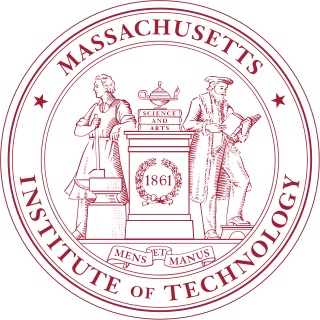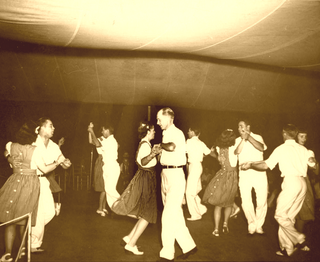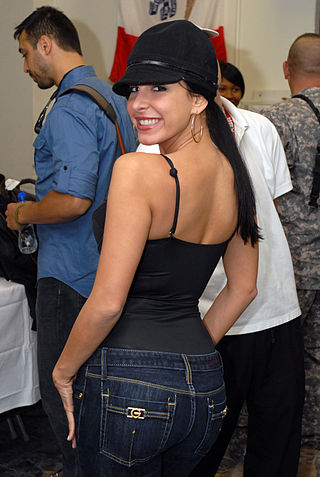
Contra dance is a form of folk dancing made up of long lines of couples. It has mixed origins from English country dance, Scottish country dance, and French dance styles in the 17th century. Sometimes described as New England folk dance or Appalachian folk dance, contra dances can be found around the world, but are most common in the United States, Canada, and other Anglophone countries.

The Massachusetts Institute of Technology (MIT) is a private land-grant research university in Cambridge, Massachusetts. Established in 1861, MIT has played a significant role in the development of many areas of modern technology and science.

A country dance is any of a very large number of social dances of a type that originated in the British Isles; it is the repeated execution of a predefined sequence of figures, carefully designed to fit a fixed length of music, performed by a group of people, usually in couples, in one or more sets. The figures involve interaction with your partner and/or with other dancers, usually with a progression so that you dance with everyone in your set. It is common in modern times to have a "caller" who teaches the dance and then calls the figures as you dance. Country dances are done in many different styles.

A square dance is a dance for four couples, or eight dancers in total, arranged in a square, with one couple on each side, facing the middle of the square. Square dances are part of a broad spectrum of dances known by various names: country dances, traditional dances, folk dances, barn dances, ceilidh dances, contra dances, Playford dances, etc. These dances appear in over 100 different formations, of which the Square and the Longways Set are by far the most popular formations.

Gay square dance is square dance as it is generally danced in the Gay and Lesbian community. The first gay and lesbian square dance clubs formed in the mid-to-late 1970s in the USA. There are currently about eighty gay square dance clubs worldwide.

Modern western square dance is one of two American types of square dancing, along with traditional square dance. As a dance form, modern western square dance grew out of traditional square dance in the American West. The term western square dance, for some, is synonymous with "cowboy dance" or traditional western square dance. Therefore, this article uses the term "modern western square dance" to describe the contemporary non-historical dance which grew out of the traditional dance. Modern western square dance was the official dance of the United States from 1982 to 1993.

The Tech Model Railroad Club (TMRC) is a student organization at the Massachusetts Institute of Technology (MIT). Historically it has been a wellspring of hacker culture and the oldest such hacking group in North America. Formed in 1946, its HO scale layout specializes in automated operation of model trains.
Square dance clubs are the primary form for organization within the recreational activity of square dancing, and more specifically modern western square dance. This article's focus is the modern western square dance club, and it is understood in the context of this article that when the terms "square dance club" or "square dance" are used it refers to the form of square dance called "modern western square dance".

Guy Lewis Steele Jr. is an American computer scientist who has played an important role in designing and documenting several computer programming languages and technical standards.
A caller is a person who prompts dance figures in such dances as line dance, square dance, and contra dance. The caller might be one of the participating dancers, though in modern country dance this is rare.

Mayra Verónica Aruca Rodríguez is an American singer, model, actress, and television public figure who became popular for her appearances on Spanish-language television. Verónica's role in Univision's Don Francisco Presenta brought her to the attention of FHM magazine's US edition. After appearing in FHM, she was included in its 2004 calendar and went on to do additional magazine work. She has taken part in many Spanish-language television shows, as well as appearing in music videos and television commercials.

Joe Aillet Stadium is a college football stadium in Ruston, Louisiana and the home field of the Louisiana Tech University Bulldogs football team, which competes in Conference USA. The football stadium replaced the original Tech Stadium where the school's football program played its home games on campus until 1967.
Youth square dancing is square dancing among people up to their mid-twenties. In specific contexts, e.g., in qualification for some event, it may refer to dancers up to a particular age such as 18. It also may refer to a style of dancing that, while most popular among younger dancers, can be enjoyed by some older dancers.
A square dance program or square dance list is a set of defined square dance calls or dance steps which are associated with a level of difficulty. Programs and program lists are managed and universally recognized in modern western square dance.
Challenge square dance, also known as Challenge dancing, is modern western square dance focused on the puzzle-solving aspects of square dancing at the most difficult or "challenging" levels.
John Burroughs High School is a public high school located in Burbank, in Los Angeles County. It is known for its notable alumni, and being the filming location for many television shows.

The traditions and student activities at the Massachusetts Institute of Technology encompass hundreds of student activities, organizations, and athletics that contribute to MIT's distinct culture.

Community Charter School of Cambridge is a charter school located in Cambridge, Massachusetts, United States. Located in the Kendall Square area near MIT, the school serves 360 students in grades 6-12. CCSC opened in September 2005. Since 2009, when CCSC graduated its first class, 100% of seniors have been admitted to college, with over 90% to four-year schools including Boston College, Bucknell University, Cornell University, Columbia University, Dartmouth College, Northeastern University, UMass Boston, University of Chicago, Stanford University, and Massachusetts Institute of Technology. In 2013, 100% of CCSC 10th graders scored advanced or proficient on the ELA MCAS. In 2012, 100% of 10th graders at CCSC scored advanced or proficient on both the math and English MCAS tests, earning the school a #1 ranking statewide. In 2011, CCSC was 1 of 14 charter schools in the U.S. to be awarded an EPIC grant for attaining the highest gains in student achievement.
Square Dance Jubilee is a 1949 American Western musical film directed by Paul Landres starring Don "Red" Barry, Mary Beth Hughes and Wally Vernon.












